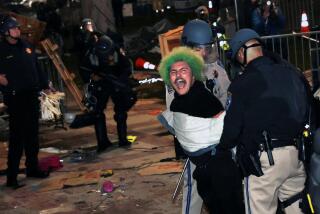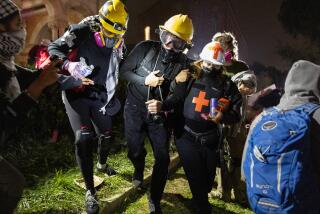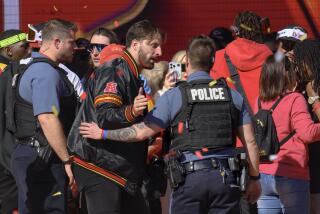St. Louis police, state troopers to monitor protests after Ferguson ambush
- Share via
St. Louis County and Missouri state troopers are taking responsibility for monitoring protests in Ferguson, Mo., starting Thursday evening as police hunt for the shooter who wounded two police officers during a protest.
No arrests have been announced in the attack, which St. Louis County Police Chief Jon Belmar characterized as an “ambush” of officers in riot gear who were protecting the Ferguson Police Department early Thursday.
The two unnamed officers were treated and released from the hospital Thursday morning, a spokesman for St. Louis County police said, as President Obama and other top public officials released statements condemning the violence. U.S. Atty. Gen. Eric H. Holder Jr. called the shooter a “damn punk.”
Local activists also condemned the violence, and seven witnesses told the Los Angeles Times that the shots did not come from a group of several dozen demonstrators who were standing in parking lots near police headquarters, but from an unknown shooter or shooters on a hill overlooking the station where police had gathered.
After daylight broke Thursday, police, some in tactical gear, searched a home in the area as part of the investigation, according to a St. Louis County police spokesman. They made no arrests there despite local reports that officials led three people away in handcuffs.
“Our Tactical Operations Unit only assisted our Crimes Against Persons detectives with a house as part of the investigation,” St. Louis County Police spokesman Shawn McGuire told The Times. “Handcuffs are a safety measure when we don’t know someone. They are not under arrest.”
Shell casings were found near the site of the shooting, police said. “We feel like it’s a pistol or a handgun,” Belmar told reporters at a news conference.
A 32-year-old Webster Groves officer was shot in the cheek under his right eye and has a bullet lodged beneath his ear, and a 41-year-old St. Louis County police officer was shot in the shoulder; the bullet exited through his back between the scapula and the spine, Belmar said. The bullets did not hit any vital organs, he said.
The two were among dozens of officers with a multi-agency security detail that had gathered in riot gear to protect the Ferguson Police Department during a sometimes-tense protest.
“We were very close to having happen what happened with NYPD,” Belmar said, referring to two New York police officers killed in a December ambush in Brooklyn by a suicidal gunman who suggested on social media that he was seeking revenge for black men killed by the police. “We could have buried two police officers.
“We really need to understand the dangers of this,” Belmar said of the ‘s protest, which officials had deemed serious enough to set up a line of officers in an area without much defensive cover. “I’m not blaming anybody other than the individuals who took a shot at my officers and hit them, but I am telling you, these are situations that are very difficult to navigate through if you’re a police officer on the street.”
Belmar said of the demonstrators, some of whom were shouting at the officers during the protest: “We have an obligation [to those] who want to express their 1st Amendment rights … but when you look at the tenor of at least some of the people … it, at times, can be very troubling.”
The shooting came on one of the first warm nights of the year and rocked the St. Louis area, which had a relatively quiet winter after the tumult of summer and fall protests and violence in Ferguson after the Aug. 9 shooting death of Michael Brown, an unarmed 18-year-old black man, by a white Ferguson police officer, Darren Wilson.
“Violence against police is unacceptable. Our prayers are with the officers in MO. Path to justice is one all of us must travel together. –bo,” said a tweet from the White House on Thursday that indicated the message was written personally by President Obama.
Brown’s family released a statement condemning the attack, calling it a “senseless shooting.”
“We reject any kind of violence directed toward members of law enforcement. It cannot and will not be tolerated,” the statement read. “We specifically denounce the actions of stand-alone agitators who unsuccessfully attempt to derail the otherwise peaceful and non-violent movement that has emerged throughout this nation to confront police brutality and to forward the cause of equality under the law for all.
“We must work together to bring peace to our communities. Our thoughts and prayers remain with the officers injured during this morning’s shooting and their families.”
Holder called Thursday’s shooting “inexcusable and repugnant.”
“What happened last night was a pure ambush. This was not someone trying to bring healing to Ferguson. This was a damn punk.
“Such senseless acts of violence threaten the very reforms that nonviolent protesters in Ferguson and around the country have been working towards for the past several months,” Holder said, offering whatever federal aid local officials needed.
In a statement on behalf of the city of Ferguson, Mayor James W. Knowles III said the shooting “has no place in our community or our country.”
“Violence cannot and will not be tolerated in the City of Ferguson.... The city continues to take corrective action to address issues that have been brought out since August 9. ... We are committed to making sure that our police department and court system operate under the principles of professionalism and fairness,” the statement read.
“While we respect the right to peacefully protest, we cannot continue to move forward under threats of violence and destruction to our community. We ask our residents and clergy in this area to partner with us as we make our way through this process.”
Missouri Gov. Jay Nixon also called the shooting “senseless” and said his thoughts and prayers also were with the officers.
“Each day, our law enforcement officers risk their lives to protect the public, and the fact that these officers appear to have been intentionally targeted is deeply troubling,” Nixon said in a statement, promising state troopers would lend their aid if needed.
Almost immediately after the shooting, a top local activist who was present, DeRay Mckesson, tweeted: “I do not condone the killing of police officers. I do not condone the killing of the unarmed. I do not condone killing.”
The protests and shooting happened only a few hours after embattled Ferguson Police Chief Thomas Jackson announced that he would resign March 19, following last week’s critical U.S. Justice Department report that accused Ferguson police of targeting and harassing the St. Louis suburb’s predominantly black residents.
The attack was an ugly flashback to the most dangerous moments of the unrest last year in Ferguson, where sporadic gunfire sometimes erupted late at night as protests dissolved into chaos. In the last few weeks, Ferguson’s civic leadership has been in flux and the future of its Police Department uncertain.
Justice Department representatives were set to travel to Ferguson in the coming weeks to discuss the investigation’s findings and a possible court-enforceable agreement for reform.
Since the DOJ report, a wave of change swept over Ferguson — including the firing or resignation of a police captain, a police sergeant, a court clerk, a municipal judge, the city manager and, now, the chief of police — but it still may not be enough to satisfy a corps of die-hard activists that have maintained the pressure on city officials.
A crowd, perhaps reaching as many as 200 people at one point, had gathered outside the Ferguson Police Department on Wednesday evening both to celebrate Chief Jackson’s resignation and to push for the resignation of Mayor Knowles, some participants said.
The crowd had begun winding down after midnight, with maybe 50 people scattered between two parking lots across the street from police headquarters when the shots were fired.
Belmar said “these protesters were among the shooters who shot at the police officers,” but many witnesses at the scene disputed that claim.
Seven such witnesses told the The Times that the shots came up Tiffin Avenue on a hill behind where protesters had gathered in the parking lot of a tire store and in another parking lot across Tiffin Avenue, both of which face the Police Department.
“The shots definitely came up from behind us, up the street,” Mike Kinman, 46, an Episcopal priest at Christ Church Cathedral in St. Louis and a sometime demonstrator who arrived at the scene five minutes before the shots were fired. “It definitely did not come from the protesters.”
“I didn’t see any protesters on the street” where the shots came from “up the hill,” said Johnetta Elzie, a prominent Ferguson activist.
“We heard, like, a firework — we thought it was a firework — it was loud,” said Bradley Rayford, a local journalist.
“You couldn’t even see where it was coming from, but you saw the muzzle” flash from up the hill, Rayford said. “The bullets went right past my head.”
“We all ducked down” and the police took cover, Rayford said. “I saw a cop on the ground, obviously in pain; they had to drag him from the front lines.”
In an amateur video, shots ring out and a man is heard screaming in pain. Someone at the scene, unseen and unidentified in the video, yells out: “Acknowledgment nine months ago would have kept that from happening.”
Several witnesses said at least four shots were fired.
“It was the first time I’d heard a bullet whiz and pass my head,” said Tony Tice, a Ferguson resident and activist, adding that several officers dropped their riot shields to take cover. “There’s a bunch of shields on the ground,” he said.
One officer fell to the ground and yelled out, apparently wounded, and fellow officers surrounded him and carried him inside, Rice said.
Rice said he didn’t see who fired the shots. “They were way up the hill” and concealed in the dark, he said.
“It came from behind us,” said Heather De Mian, who was recording the events on a live stream.
“The crowd [had] been dispersing” when the shots were fired, De Mian said. Afterward, police with rifles were on scene. Some protesters remained. “It’s kind of scary,” De Mian said.
“It was really pretty mellow at that point,” Kinman said of the protest prior to the shooting.
He too has been an active participant in the demonstrations since August. Demonstrators were “standing around talking” in the parking lot when four or five shots “in rapid succession” sent protesters and officers ducking for cover, he said.
“A bunch of officers went down to the ground, and there was one that just didn’t move,” Kinman said.
Kinman’s account was seconded by another protester, Elle Dowd. “It was up the street behind the protesters,” Dowd told The Times.
“My prayers are with the officers; this is terrible,” Kinman said. “The people behind [the protest movement] are 100% nonviolent, this is never anything that we want. I’m really shaken up by this. Right now we’re concentrating our prayers on the officers and their families.”
Mckesson, an activist at the scene, told The Times that there were at least four shots, but they were not quite rapid-fire.
“The shots did not come from any lot with protesters,” Mckesson said in a tweet. He added that immediately after the shooting, when describing how demonstrators scattered and police headed toward the source of the gunfire: “The police know that protesters weren’t the shooter. That’s why they didn’t detain us. They went for the hill where none of us were.”
Elzie added that “I have no idea” what happens next, only that the local community and activist leaders would soon hold a meeting to determine the next steps. But she said wasn’t giving up her mission.
“Honestly I’m still focused on the movement, it’s still police accountability, it’s still basically demanding the police stop killing us without being held accountable,” Elzie told The Times. “I don’t think the movement has lost any momentum. I feel like if you were already a supporter of the movement, you [still] are, if you were a supporter of anti-police accountability, you still are. I don’t think much has changed on that front.”
Times staff writer Timothy M. Phelps contributed to this report from Washington.
Follow @mattpearce for national news
More to Read
Sign up for Essential California
The most important California stories and recommendations in your inbox every morning.
You may occasionally receive promotional content from the Los Angeles Times.











